Economic principles and decision making
VerifiedAdded on 2022/09/18
|15
|4552
|24
AI Summary
Contribute Materials
Your contribution can guide someone’s learning journey. Share your
documents today.
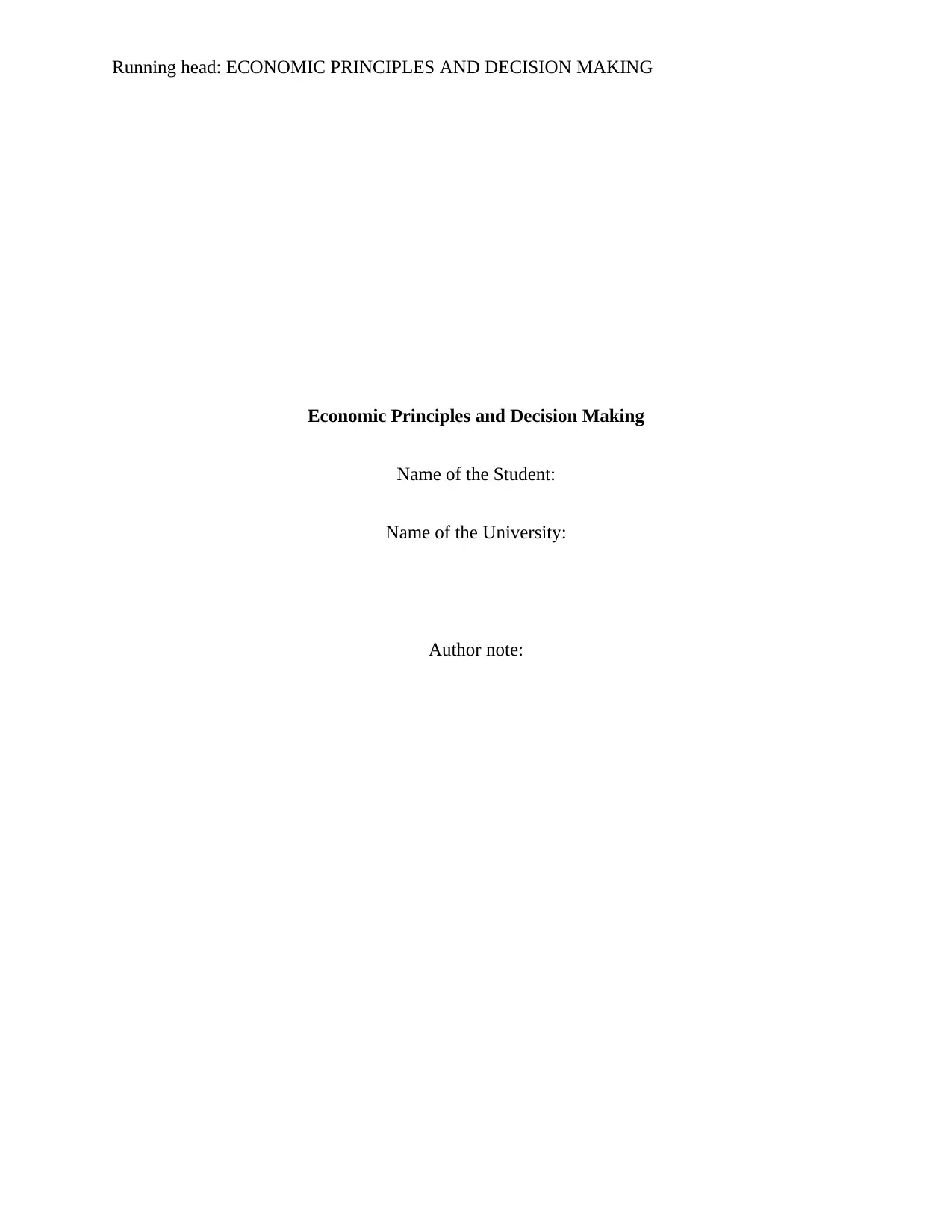
Running head: ECONOMIC PRINCIPLES AND DECISION MAKING
Economic Principles and Decision Making
Name of the Student:
Name of the University:
Author note:
Economic Principles and Decision Making
Name of the Student:
Name of the University:
Author note:
Secure Best Marks with AI Grader
Need help grading? Try our AI Grader for instant feedback on your assignments.
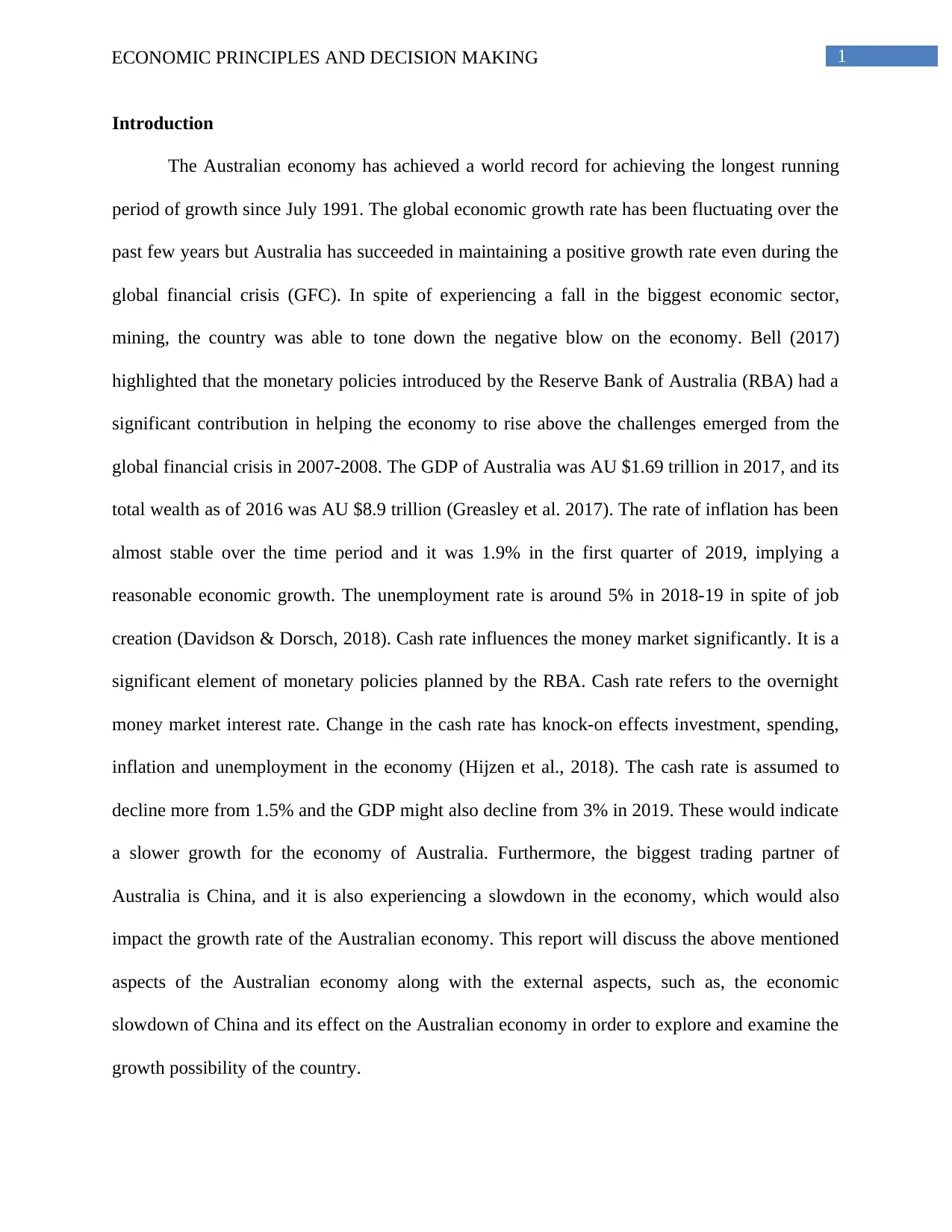
1ECONOMIC PRINCIPLES AND DECISION MAKING
Introduction
The Australian economy has achieved a world record for achieving the longest running
period of growth since July 1991. The global economic growth rate has been fluctuating over the
past few years but Australia has succeeded in maintaining a positive growth rate even during the
global financial crisis (GFC). In spite of experiencing a fall in the biggest economic sector,
mining, the country was able to tone down the negative blow on the economy. Bell (2017)
highlighted that the monetary policies introduced by the Reserve Bank of Australia (RBA) had a
significant contribution in helping the economy to rise above the challenges emerged from the
global financial crisis in 2007-2008. The GDP of Australia was AU $1.69 trillion in 2017, and its
total wealth as of 2016 was AU $8.9 trillion (Greasley et al. 2017). The rate of inflation has been
almost stable over the time period and it was 1.9% in the first quarter of 2019, implying a
reasonable economic growth. The unemployment rate is around 5% in 2018-19 in spite of job
creation (Davidson & Dorsch, 2018). Cash rate influences the money market significantly. It is a
significant element of monetary policies planned by the RBA. Cash rate refers to the overnight
money market interest rate. Change in the cash rate has knock-on effects investment, spending,
inflation and unemployment in the economy (Hijzen et al., 2018). The cash rate is assumed to
decline more from 1.5% and the GDP might also decline from 3% in 2019. These would indicate
a slower growth for the economy of Australia. Furthermore, the biggest trading partner of
Australia is China, and it is also experiencing a slowdown in the economy, which would also
impact the growth rate of the Australian economy. This report will discuss the above mentioned
aspects of the Australian economy along with the external aspects, such as, the economic
slowdown of China and its effect on the Australian economy in order to explore and examine the
growth possibility of the country.
Introduction
The Australian economy has achieved a world record for achieving the longest running
period of growth since July 1991. The global economic growth rate has been fluctuating over the
past few years but Australia has succeeded in maintaining a positive growth rate even during the
global financial crisis (GFC). In spite of experiencing a fall in the biggest economic sector,
mining, the country was able to tone down the negative blow on the economy. Bell (2017)
highlighted that the monetary policies introduced by the Reserve Bank of Australia (RBA) had a
significant contribution in helping the economy to rise above the challenges emerged from the
global financial crisis in 2007-2008. The GDP of Australia was AU $1.69 trillion in 2017, and its
total wealth as of 2016 was AU $8.9 trillion (Greasley et al. 2017). The rate of inflation has been
almost stable over the time period and it was 1.9% in the first quarter of 2019, implying a
reasonable economic growth. The unemployment rate is around 5% in 2018-19 in spite of job
creation (Davidson & Dorsch, 2018). Cash rate influences the money market significantly. It is a
significant element of monetary policies planned by the RBA. Cash rate refers to the overnight
money market interest rate. Change in the cash rate has knock-on effects investment, spending,
inflation and unemployment in the economy (Hijzen et al., 2018). The cash rate is assumed to
decline more from 1.5% and the GDP might also decline from 3% in 2019. These would indicate
a slower growth for the economy of Australia. Furthermore, the biggest trading partner of
Australia is China, and it is also experiencing a slowdown in the economy, which would also
impact the growth rate of the Australian economy. This report will discuss the above mentioned
aspects of the Australian economy along with the external aspects, such as, the economic
slowdown of China and its effect on the Australian economy in order to explore and examine the
growth possibility of the country.

2ECONOMIC PRINCIPLES AND DECISION MAKING
Discussion
Economic growth and impact of cash rate
Economic growth refers to the expansion or increase in the size of the economy of a
country over a given period of time. The economy’s size is generally measured by its Gross
Domestic Product (GDP), which represents the total level of goods and services produced within
the geographic boundaries of a nation in a given period of time (Minford & Peel, 2019). The
GDP of a nation depends on different factors of production combined with several other
intangible aspects of the economy, such as, demand and expenditure level, money supply, rate of
interest, inflation and unemployment, tax rates, import and export levels, tariffs etc. (Johnson,
2017). Thus, RBA plays a significant role in influencing the aggregate level of goods and
services production in the Australian economy. Cash rate is a significant measure among all the
other measures planned and implemented by the RBA for controlling the money supply in the
market. This in turn affects the market forces, that is, the demand and supply of the goods and
services in the Australian economy and other variables influencing economic growth.
According to RBA (2019), cash rate denotes the metric, which is used for representing
the interest rate on the overnight funds. The overnight funds refer to those that are used by the
commercial banks to lend money to each other to meet their daily cash needs on an immediate
basis. It also serves as the benchmark rate for all kinds of lending, like, rates of interest on the
savings accounts, mortgages, rates of exchange, and many other lending transactions in the
monetary policy implemented by the RBA. Thus, the cash rate impacts all types of channels of
money supply within the economy. It can be explained in the following way; when there is rising
inflation in the economy, that is, the economy is strong and the prices of goods and services are
pushed up by the market demand, then RBA raises the cash rate for slowing down the economy
Discussion
Economic growth and impact of cash rate
Economic growth refers to the expansion or increase in the size of the economy of a
country over a given period of time. The economy’s size is generally measured by its Gross
Domestic Product (GDP), which represents the total level of goods and services produced within
the geographic boundaries of a nation in a given period of time (Minford & Peel, 2019). The
GDP of a nation depends on different factors of production combined with several other
intangible aspects of the economy, such as, demand and expenditure level, money supply, rate of
interest, inflation and unemployment, tax rates, import and export levels, tariffs etc. (Johnson,
2017). Thus, RBA plays a significant role in influencing the aggregate level of goods and
services production in the Australian economy. Cash rate is a significant measure among all the
other measures planned and implemented by the RBA for controlling the money supply in the
market. This in turn affects the market forces, that is, the demand and supply of the goods and
services in the Australian economy and other variables influencing economic growth.
According to RBA (2019), cash rate denotes the metric, which is used for representing
the interest rate on the overnight funds. The overnight funds refer to those that are used by the
commercial banks to lend money to each other to meet their daily cash needs on an immediate
basis. It also serves as the benchmark rate for all kinds of lending, like, rates of interest on the
savings accounts, mortgages, rates of exchange, and many other lending transactions in the
monetary policy implemented by the RBA. Thus, the cash rate impacts all types of channels of
money supply within the economy. It can be explained in the following way; when there is rising
inflation in the economy, that is, the economy is strong and the prices of goods and services are
pushed up by the market demand, then RBA raises the cash rate for slowing down the economy
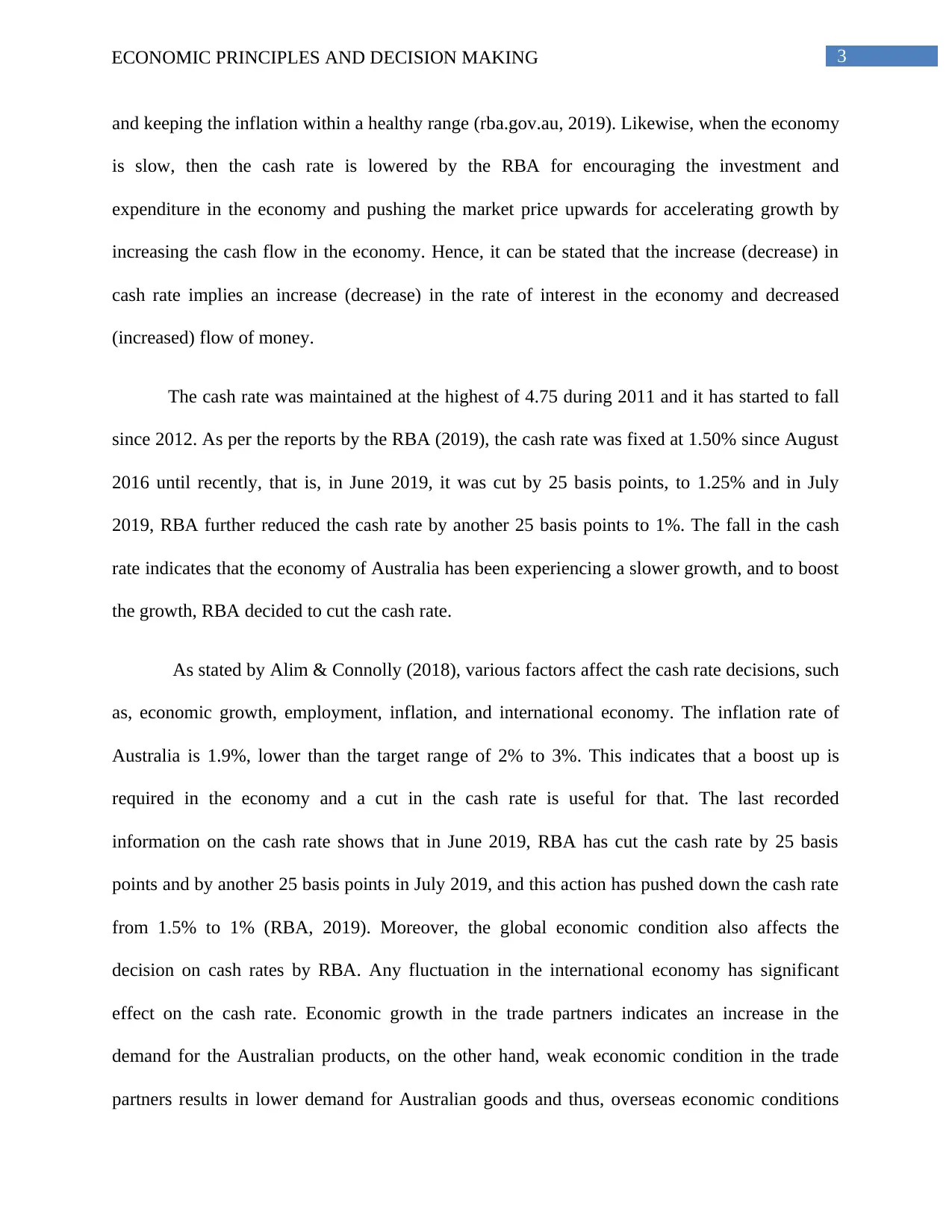
3ECONOMIC PRINCIPLES AND DECISION MAKING
and keeping the inflation within a healthy range (rba.gov.au, 2019). Likewise, when the economy
is slow, then the cash rate is lowered by the RBA for encouraging the investment and
expenditure in the economy and pushing the market price upwards for accelerating growth by
increasing the cash flow in the economy. Hence, it can be stated that the increase (decrease) in
cash rate implies an increase (decrease) in the rate of interest in the economy and decreased
(increased) flow of money.
The cash rate was maintained at the highest of 4.75 during 2011 and it has started to fall
since 2012. As per the reports by the RBA (2019), the cash rate was fixed at 1.50% since August
2016 until recently, that is, in June 2019, it was cut by 25 basis points, to 1.25% and in July
2019, RBA further reduced the cash rate by another 25 basis points to 1%. The fall in the cash
rate indicates that the economy of Australia has been experiencing a slower growth, and to boost
the growth, RBA decided to cut the cash rate.
As stated by Alim & Connolly (2018), various factors affect the cash rate decisions, such
as, economic growth, employment, inflation, and international economy. The inflation rate of
Australia is 1.9%, lower than the target range of 2% to 3%. This indicates that a boost up is
required in the economy and a cut in the cash rate is useful for that. The last recorded
information on the cash rate shows that in June 2019, RBA has cut the cash rate by 25 basis
points and by another 25 basis points in July 2019, and this action has pushed down the cash rate
from 1.5% to 1% (RBA, 2019). Moreover, the global economic condition also affects the
decision on cash rates by RBA. Any fluctuation in the international economy has significant
effect on the cash rate. Economic growth in the trade partners indicates an increase in the
demand for the Australian products, on the other hand, weak economic condition in the trade
partners results in lower demand for Australian goods and thus, overseas economic conditions
and keeping the inflation within a healthy range (rba.gov.au, 2019). Likewise, when the economy
is slow, then the cash rate is lowered by the RBA for encouraging the investment and
expenditure in the economy and pushing the market price upwards for accelerating growth by
increasing the cash flow in the economy. Hence, it can be stated that the increase (decrease) in
cash rate implies an increase (decrease) in the rate of interest in the economy and decreased
(increased) flow of money.
The cash rate was maintained at the highest of 4.75 during 2011 and it has started to fall
since 2012. As per the reports by the RBA (2019), the cash rate was fixed at 1.50% since August
2016 until recently, that is, in June 2019, it was cut by 25 basis points, to 1.25% and in July
2019, RBA further reduced the cash rate by another 25 basis points to 1%. The fall in the cash
rate indicates that the economy of Australia has been experiencing a slower growth, and to boost
the growth, RBA decided to cut the cash rate.
As stated by Alim & Connolly (2018), various factors affect the cash rate decisions, such
as, economic growth, employment, inflation, and international economy. The inflation rate of
Australia is 1.9%, lower than the target range of 2% to 3%. This indicates that a boost up is
required in the economy and a cut in the cash rate is useful for that. The last recorded
information on the cash rate shows that in June 2019, RBA has cut the cash rate by 25 basis
points and by another 25 basis points in July 2019, and this action has pushed down the cash rate
from 1.5% to 1% (RBA, 2019). Moreover, the global economic condition also affects the
decision on cash rates by RBA. Any fluctuation in the international economy has significant
effect on the cash rate. Economic growth in the trade partners indicates an increase in the
demand for the Australian products, on the other hand, weak economic condition in the trade
partners results in lower demand for Australian goods and thus, overseas economic conditions
Secure Best Marks with AI Grader
Need help grading? Try our AI Grader for instant feedback on your assignments.
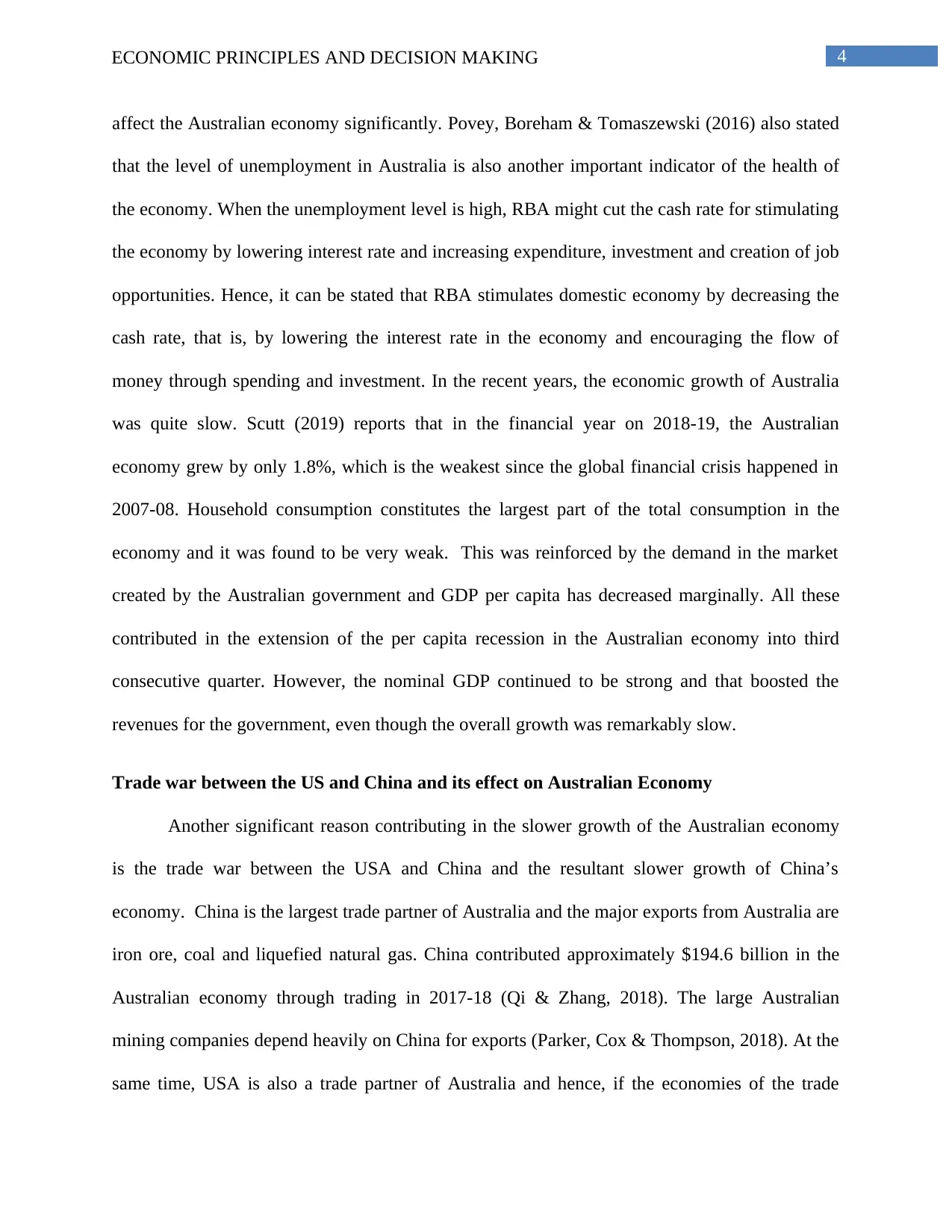
4ECONOMIC PRINCIPLES AND DECISION MAKING
affect the Australian economy significantly. Povey, Boreham & Tomaszewski (2016) also stated
that the level of unemployment in Australia is also another important indicator of the health of
the economy. When the unemployment level is high, RBA might cut the cash rate for stimulating
the economy by lowering interest rate and increasing expenditure, investment and creation of job
opportunities. Hence, it can be stated that RBA stimulates domestic economy by decreasing the
cash rate, that is, by lowering the interest rate in the economy and encouraging the flow of
money through spending and investment. In the recent years, the economic growth of Australia
was quite slow. Scutt (2019) reports that in the financial year on 2018-19, the Australian
economy grew by only 1.8%, which is the weakest since the global financial crisis happened in
2007-08. Household consumption constitutes the largest part of the total consumption in the
economy and it was found to be very weak. This was reinforced by the demand in the market
created by the Australian government and GDP per capita has decreased marginally. All these
contributed in the extension of the per capita recession in the Australian economy into third
consecutive quarter. However, the nominal GDP continued to be strong and that boosted the
revenues for the government, even though the overall growth was remarkably slow.
Trade war between the US and China and its effect on Australian Economy
Another significant reason contributing in the slower growth of the Australian economy
is the trade war between the USA and China and the resultant slower growth of China’s
economy. China is the largest trade partner of Australia and the major exports from Australia are
iron ore, coal and liquefied natural gas. China contributed approximately $194.6 billion in the
Australian economy through trading in 2017-18 (Qi & Zhang, 2018). The large Australian
mining companies depend heavily on China for exports (Parker, Cox & Thompson, 2018). At the
same time, USA is also a trade partner of Australia and hence, if the economies of the trade
affect the Australian economy significantly. Povey, Boreham & Tomaszewski (2016) also stated
that the level of unemployment in Australia is also another important indicator of the health of
the economy. When the unemployment level is high, RBA might cut the cash rate for stimulating
the economy by lowering interest rate and increasing expenditure, investment and creation of job
opportunities. Hence, it can be stated that RBA stimulates domestic economy by decreasing the
cash rate, that is, by lowering the interest rate in the economy and encouraging the flow of
money through spending and investment. In the recent years, the economic growth of Australia
was quite slow. Scutt (2019) reports that in the financial year on 2018-19, the Australian
economy grew by only 1.8%, which is the weakest since the global financial crisis happened in
2007-08. Household consumption constitutes the largest part of the total consumption in the
economy and it was found to be very weak. This was reinforced by the demand in the market
created by the Australian government and GDP per capita has decreased marginally. All these
contributed in the extension of the per capita recession in the Australian economy into third
consecutive quarter. However, the nominal GDP continued to be strong and that boosted the
revenues for the government, even though the overall growth was remarkably slow.
Trade war between the US and China and its effect on Australian Economy
Another significant reason contributing in the slower growth of the Australian economy
is the trade war between the USA and China and the resultant slower growth of China’s
economy. China is the largest trade partner of Australia and the major exports from Australia are
iron ore, coal and liquefied natural gas. China contributed approximately $194.6 billion in the
Australian economy through trading in 2017-18 (Qi & Zhang, 2018). The large Australian
mining companies depend heavily on China for exports (Parker, Cox & Thompson, 2018). At the
same time, USA is also a trade partner of Australia and hence, if the economies of the trade

5ECONOMIC PRINCIPLES AND DECISION MAKING
partners get affected due to trade war, that would affect Australia’s economy also. The trade war
between the USA and China was started when the US government decided in 2018 to apply tariff
on the Chinese imports worth of US $50-60 billion with the assistance of the United States Trade
Representative (USTR) with an aim to reduce the unfair trade practices by China over the years.
The unfair practices also included the theft of intellectual property of the USA (Liu & Woo,
2018). The government listed more than 1300 categories of Chinese goods for tariffs, such as,
medical devices, batteries, aircraft parts, various weapons, flat-panel television and satellites
(Guttmann et al., 2019). In the response to the tariff imposition by the US, China imposed tariffs
on around 128 product types that are imported from the US. These include cars, airplanes,
soybeans, pork, fruits and nuts, steel piping and aluminium, (Liu & Woo, 2018). In the next
course of time, both the countries kept on imposing as well as increasing tariffs on imported
goods worth of billions. Because of these economic turbulences, the exports of the Chinese
economy have been affected and it has been experiencing a slowdown. Furthermore, there are
some other macroeconomic issues also, such as, diminishing birth rate, speedily aging
population, tightening Federal Reserve and a slackening global economy (Loke, 2018), which
are also contributing in the economic slowdown of China. The Chinese economy experienced
only 6.6% growth in 2018 which is a sharp fall from 10% in 2011 (RBA, 2019).
The Chinese economy is the second biggest in the world and slowdown of this economy
has significant consequence on the global economy. As the trade relations between China and
Australia are quite strong, a slowdown in China’s economy is likely to have a negative effect on
Australia’s economy. As highlighted by Qi & Zhang (2018), at least one-third of the total exports
from Australia goes to China, and, if the US government makes a deal with China to reduce the
USD 400 billion trade gap, the Australian economy would likely to suffer. It is estimated that to
partners get affected due to trade war, that would affect Australia’s economy also. The trade war
between the USA and China was started when the US government decided in 2018 to apply tariff
on the Chinese imports worth of US $50-60 billion with the assistance of the United States Trade
Representative (USTR) with an aim to reduce the unfair trade practices by China over the years.
The unfair practices also included the theft of intellectual property of the USA (Liu & Woo,
2018). The government listed more than 1300 categories of Chinese goods for tariffs, such as,
medical devices, batteries, aircraft parts, various weapons, flat-panel television and satellites
(Guttmann et al., 2019). In the response to the tariff imposition by the US, China imposed tariffs
on around 128 product types that are imported from the US. These include cars, airplanes,
soybeans, pork, fruits and nuts, steel piping and aluminium, (Liu & Woo, 2018). In the next
course of time, both the countries kept on imposing as well as increasing tariffs on imported
goods worth of billions. Because of these economic turbulences, the exports of the Chinese
economy have been affected and it has been experiencing a slowdown. Furthermore, there are
some other macroeconomic issues also, such as, diminishing birth rate, speedily aging
population, tightening Federal Reserve and a slackening global economy (Loke, 2018), which
are also contributing in the economic slowdown of China. The Chinese economy experienced
only 6.6% growth in 2018 which is a sharp fall from 10% in 2011 (RBA, 2019).
The Chinese economy is the second biggest in the world and slowdown of this economy
has significant consequence on the global economy. As the trade relations between China and
Australia are quite strong, a slowdown in China’s economy is likely to have a negative effect on
Australia’s economy. As highlighted by Qi & Zhang (2018), at least one-third of the total exports
from Australia goes to China, and, if the US government makes a deal with China to reduce the
USD 400 billion trade gap, the Australian economy would likely to suffer. It is estimated that to
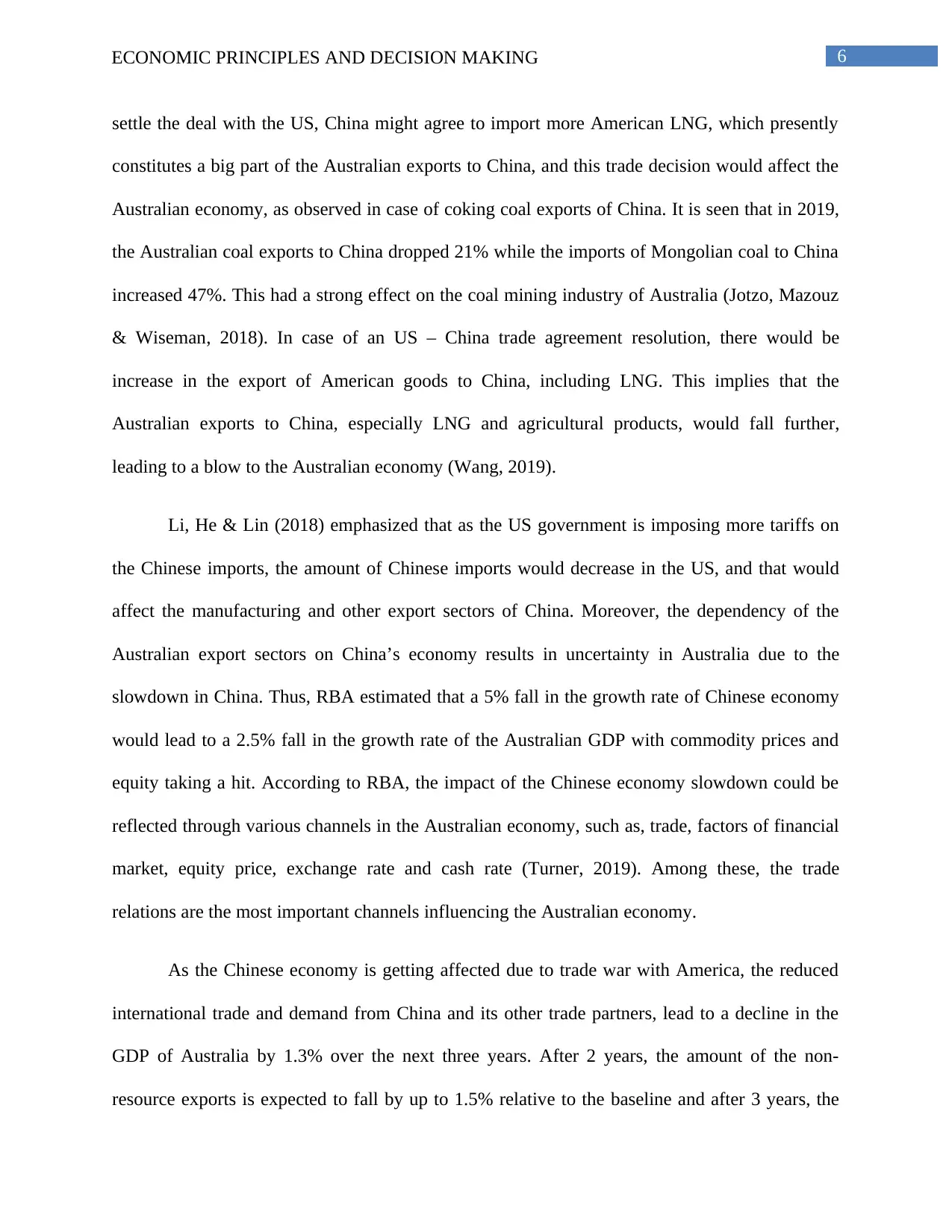
6ECONOMIC PRINCIPLES AND DECISION MAKING
settle the deal with the US, China might agree to import more American LNG, which presently
constitutes a big part of the Australian exports to China, and this trade decision would affect the
Australian economy, as observed in case of coking coal exports of China. It is seen that in 2019,
the Australian coal exports to China dropped 21% while the imports of Mongolian coal to China
increased 47%. This had a strong effect on the coal mining industry of Australia (Jotzo, Mazouz
& Wiseman, 2018). In case of an US – China trade agreement resolution, there would be
increase in the export of American goods to China, including LNG. This implies that the
Australian exports to China, especially LNG and agricultural products, would fall further,
leading to a blow to the Australian economy (Wang, 2019).
Li, He & Lin (2018) emphasized that as the US government is imposing more tariffs on
the Chinese imports, the amount of Chinese imports would decrease in the US, and that would
affect the manufacturing and other export sectors of China. Moreover, the dependency of the
Australian export sectors on China’s economy results in uncertainty in Australia due to the
slowdown in China. Thus, RBA estimated that a 5% fall in the growth rate of Chinese economy
would lead to a 2.5% fall in the growth rate of the Australian GDP with commodity prices and
equity taking a hit. According to RBA, the impact of the Chinese economy slowdown could be
reflected through various channels in the Australian economy, such as, trade, factors of financial
market, equity price, exchange rate and cash rate (Turner, 2019). Among these, the trade
relations are the most important channels influencing the Australian economy.
As the Chinese economy is getting affected due to trade war with America, the reduced
international trade and demand from China and its other trade partners, lead to a decline in the
GDP of Australia by 1.3% over the next three years. After 2 years, the amount of the non-
resource exports is expected to fall by up to 1.5% relative to the baseline and after 3 years, the
settle the deal with the US, China might agree to import more American LNG, which presently
constitutes a big part of the Australian exports to China, and this trade decision would affect the
Australian economy, as observed in case of coking coal exports of China. It is seen that in 2019,
the Australian coal exports to China dropped 21% while the imports of Mongolian coal to China
increased 47%. This had a strong effect on the coal mining industry of Australia (Jotzo, Mazouz
& Wiseman, 2018). In case of an US – China trade agreement resolution, there would be
increase in the export of American goods to China, including LNG. This implies that the
Australian exports to China, especially LNG and agricultural products, would fall further,
leading to a blow to the Australian economy (Wang, 2019).
Li, He & Lin (2018) emphasized that as the US government is imposing more tariffs on
the Chinese imports, the amount of Chinese imports would decrease in the US, and that would
affect the manufacturing and other export sectors of China. Moreover, the dependency of the
Australian export sectors on China’s economy results in uncertainty in Australia due to the
slowdown in China. Thus, RBA estimated that a 5% fall in the growth rate of Chinese economy
would lead to a 2.5% fall in the growth rate of the Australian GDP with commodity prices and
equity taking a hit. According to RBA, the impact of the Chinese economy slowdown could be
reflected through various channels in the Australian economy, such as, trade, factors of financial
market, equity price, exchange rate and cash rate (Turner, 2019). Among these, the trade
relations are the most important channels influencing the Australian economy.
As the Chinese economy is getting affected due to trade war with America, the reduced
international trade and demand from China and its other trade partners, lead to a decline in the
GDP of Australia by 1.3% over the next three years. After 2 years, the amount of the non-
resource exports is expected to fall by up to 1.5% relative to the baseline and after 3 years, the
Paraphrase This Document
Need a fresh take? Get an instant paraphrase of this document with our AI Paraphraser
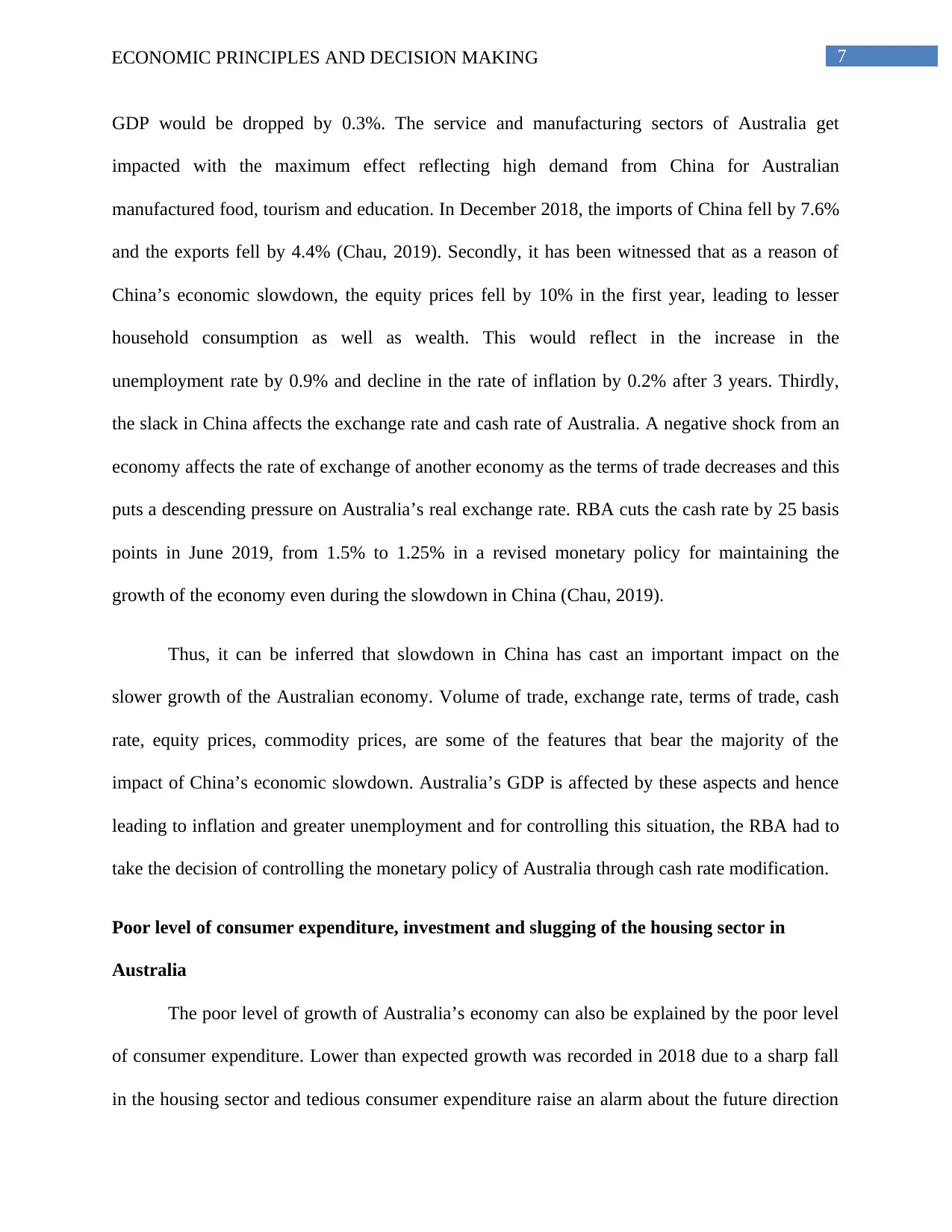
7ECONOMIC PRINCIPLES AND DECISION MAKING
GDP would be dropped by 0.3%. The service and manufacturing sectors of Australia get
impacted with the maximum effect reflecting high demand from China for Australian
manufactured food, tourism and education. In December 2018, the imports of China fell by 7.6%
and the exports fell by 4.4% (Chau, 2019). Secondly, it has been witnessed that as a reason of
China’s economic slowdown, the equity prices fell by 10% in the first year, leading to lesser
household consumption as well as wealth. This would reflect in the increase in the
unemployment rate by 0.9% and decline in the rate of inflation by 0.2% after 3 years. Thirdly,
the slack in China affects the exchange rate and cash rate of Australia. A negative shock from an
economy affects the rate of exchange of another economy as the terms of trade decreases and this
puts a descending pressure on Australia’s real exchange rate. RBA cuts the cash rate by 25 basis
points in June 2019, from 1.5% to 1.25% in a revised monetary policy for maintaining the
growth of the economy even during the slowdown in China (Chau, 2019).
Thus, it can be inferred that slowdown in China has cast an important impact on the
slower growth of the Australian economy. Volume of trade, exchange rate, terms of trade, cash
rate, equity prices, commodity prices, are some of the features that bear the majority of the
impact of China’s economic slowdown. Australia’s GDP is affected by these aspects and hence
leading to inflation and greater unemployment and for controlling this situation, the RBA had to
take the decision of controlling the monetary policy of Australia through cash rate modification.
Poor level of consumer expenditure, investment and slugging of the housing sector in
Australia
The poor level of growth of Australia’s economy can also be explained by the poor level
of consumer expenditure. Lower than expected growth was recorded in 2018 due to a sharp fall
in the housing sector and tedious consumer expenditure raise an alarm about the future direction
GDP would be dropped by 0.3%. The service and manufacturing sectors of Australia get
impacted with the maximum effect reflecting high demand from China for Australian
manufactured food, tourism and education. In December 2018, the imports of China fell by 7.6%
and the exports fell by 4.4% (Chau, 2019). Secondly, it has been witnessed that as a reason of
China’s economic slowdown, the equity prices fell by 10% in the first year, leading to lesser
household consumption as well as wealth. This would reflect in the increase in the
unemployment rate by 0.9% and decline in the rate of inflation by 0.2% after 3 years. Thirdly,
the slack in China affects the exchange rate and cash rate of Australia. A negative shock from an
economy affects the rate of exchange of another economy as the terms of trade decreases and this
puts a descending pressure on Australia’s real exchange rate. RBA cuts the cash rate by 25 basis
points in June 2019, from 1.5% to 1.25% in a revised monetary policy for maintaining the
growth of the economy even during the slowdown in China (Chau, 2019).
Thus, it can be inferred that slowdown in China has cast an important impact on the
slower growth of the Australian economy. Volume of trade, exchange rate, terms of trade, cash
rate, equity prices, commodity prices, are some of the features that bear the majority of the
impact of China’s economic slowdown. Australia’s GDP is affected by these aspects and hence
leading to inflation and greater unemployment and for controlling this situation, the RBA had to
take the decision of controlling the monetary policy of Australia through cash rate modification.
Poor level of consumer expenditure, investment and slugging of the housing sector in
Australia
The poor level of growth of Australia’s economy can also be explained by the poor level
of consumer expenditure. Lower than expected growth was recorded in 2018 due to a sharp fall
in the housing sector and tedious consumer expenditure raise an alarm about the future direction
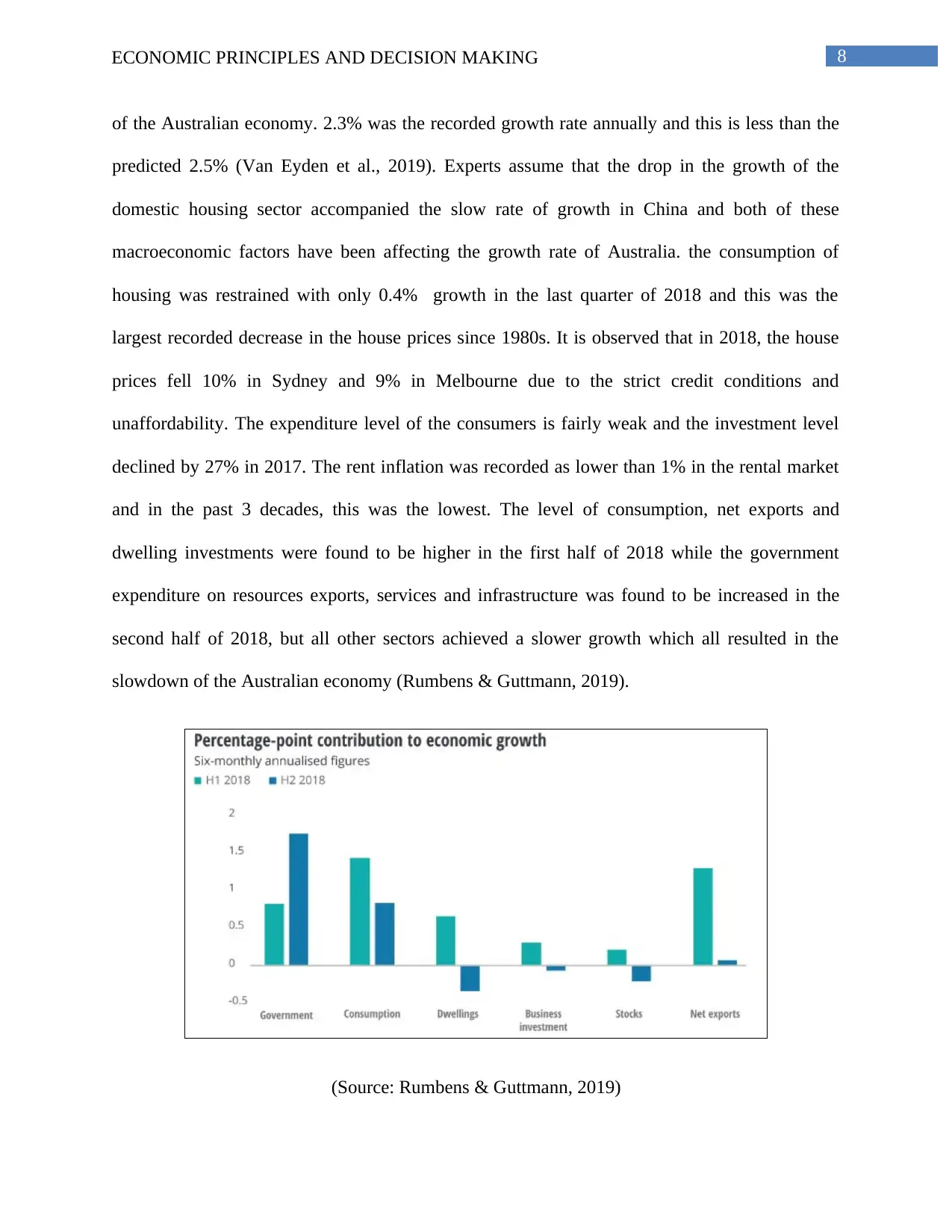
8ECONOMIC PRINCIPLES AND DECISION MAKING
of the Australian economy. 2.3% was the recorded growth rate annually and this is less than the
predicted 2.5% (Van Eyden et al., 2019). Experts assume that the drop in the growth of the
domestic housing sector accompanied the slow rate of growth in China and both of these
macroeconomic factors have been affecting the growth rate of Australia. the consumption of
housing was restrained with only 0.4% growth in the last quarter of 2018 and this was the
largest recorded decrease in the house prices since 1980s. It is observed that in 2018, the house
prices fell 10% in Sydney and 9% in Melbourne due to the strict credit conditions and
unaffordability. The expenditure level of the consumers is fairly weak and the investment level
declined by 27% in 2017. The rent inflation was recorded as lower than 1% in the rental market
and in the past 3 decades, this was the lowest. The level of consumption, net exports and
dwelling investments were found to be higher in the first half of 2018 while the government
expenditure on resources exports, services and infrastructure was found to be increased in the
second half of 2018, but all other sectors achieved a slower growth which all resulted in the
slowdown of the Australian economy (Rumbens & Guttmann, 2019).
(Source: Rumbens & Guttmann, 2019)
of the Australian economy. 2.3% was the recorded growth rate annually and this is less than the
predicted 2.5% (Van Eyden et al., 2019). Experts assume that the drop in the growth of the
domestic housing sector accompanied the slow rate of growth in China and both of these
macroeconomic factors have been affecting the growth rate of Australia. the consumption of
housing was restrained with only 0.4% growth in the last quarter of 2018 and this was the
largest recorded decrease in the house prices since 1980s. It is observed that in 2018, the house
prices fell 10% in Sydney and 9% in Melbourne due to the strict credit conditions and
unaffordability. The expenditure level of the consumers is fairly weak and the investment level
declined by 27% in 2017. The rent inflation was recorded as lower than 1% in the rental market
and in the past 3 decades, this was the lowest. The level of consumption, net exports and
dwelling investments were found to be higher in the first half of 2018 while the government
expenditure on resources exports, services and infrastructure was found to be increased in the
second half of 2018, but all other sectors achieved a slower growth which all resulted in the
slowdown of the Australian economy (Rumbens & Guttmann, 2019).
(Source: Rumbens & Guttmann, 2019)

9ECONOMIC PRINCIPLES AND DECISION MAKING
Australian economy also experienced productivity slump, and this reflected 1 of the
lowest value in successive 3 quarters. The low growth of wage is disturbing the market
productivity. Moreover, the level of investment in infrastructure is also low, indicating less flow
of money in the market. Therefore, a sharp fall in the property market and low investment and
consumer expenditure level has been affecting the growth rate of the Australian economy in
2017-18. The rise in the GDP was also much lower, recorded as only 2.3% since the mid of 2017
and this is lower than the expected 2.5%. The last quarter of 2018 witnessed a negative growth
rate of 1.6% in the agricultural forestry and fishing sector (Hutchens, 2018). Along with that, the
construction industry also faced a slowdown. All of these factors contributed in the fall of the
annual growth rate to 2.8% from 3.4% in the last quarter (Rumbens & Guttmann, 2019). Hence,
to stimulate the economy, RBA may resort to a cut in the cash rate.
RBA may decrease the corporate taxes and the cash rate to adjust the level of investment
and expenditure in the economy, to preserve a stable rate of wage and steady inflation as since
1980s, the country was experiencing a per capita recession first time (Reuters.com, 2019).
Through flexible monetary policy and revised rate cuts, the Australian government tries to
sustain the economic growth. Since, the reduced trade with China, global economic slowdown,
fall in the growth rate of manufacturing, mining and housing sector, reduction in inflation and
rise in the unemployment are resulting in the slower growth of the Australian economy, the
central bank needs to boost up the economy by increasing the supply of money into the market
and preventing more drop in the macroeconomic components.
Thus, to attain these objectives, the cash rate cut by 25 basis points seems to be a suitable
measure. By dropping the cash rate, RBA will encourage economic activities, such as,
investment and expenditure in the economy. This will also aid in gaining stability in currency
Australian economy also experienced productivity slump, and this reflected 1 of the
lowest value in successive 3 quarters. The low growth of wage is disturbing the market
productivity. Moreover, the level of investment in infrastructure is also low, indicating less flow
of money in the market. Therefore, a sharp fall in the property market and low investment and
consumer expenditure level has been affecting the growth rate of the Australian economy in
2017-18. The rise in the GDP was also much lower, recorded as only 2.3% since the mid of 2017
and this is lower than the expected 2.5%. The last quarter of 2018 witnessed a negative growth
rate of 1.6% in the agricultural forestry and fishing sector (Hutchens, 2018). Along with that, the
construction industry also faced a slowdown. All of these factors contributed in the fall of the
annual growth rate to 2.8% from 3.4% in the last quarter (Rumbens & Guttmann, 2019). Hence,
to stimulate the economy, RBA may resort to a cut in the cash rate.
RBA may decrease the corporate taxes and the cash rate to adjust the level of investment
and expenditure in the economy, to preserve a stable rate of wage and steady inflation as since
1980s, the country was experiencing a per capita recession first time (Reuters.com, 2019).
Through flexible monetary policy and revised rate cuts, the Australian government tries to
sustain the economic growth. Since, the reduced trade with China, global economic slowdown,
fall in the growth rate of manufacturing, mining and housing sector, reduction in inflation and
rise in the unemployment are resulting in the slower growth of the Australian economy, the
central bank needs to boost up the economy by increasing the supply of money into the market
and preventing more drop in the macroeconomic components.
Thus, to attain these objectives, the cash rate cut by 25 basis points seems to be a suitable
measure. By dropping the cash rate, RBA will encourage economic activities, such as,
investment and expenditure in the economy. This will also aid in gaining stability in currency
Secure Best Marks with AI Grader
Need help grading? Try our AI Grader for instant feedback on your assignments.
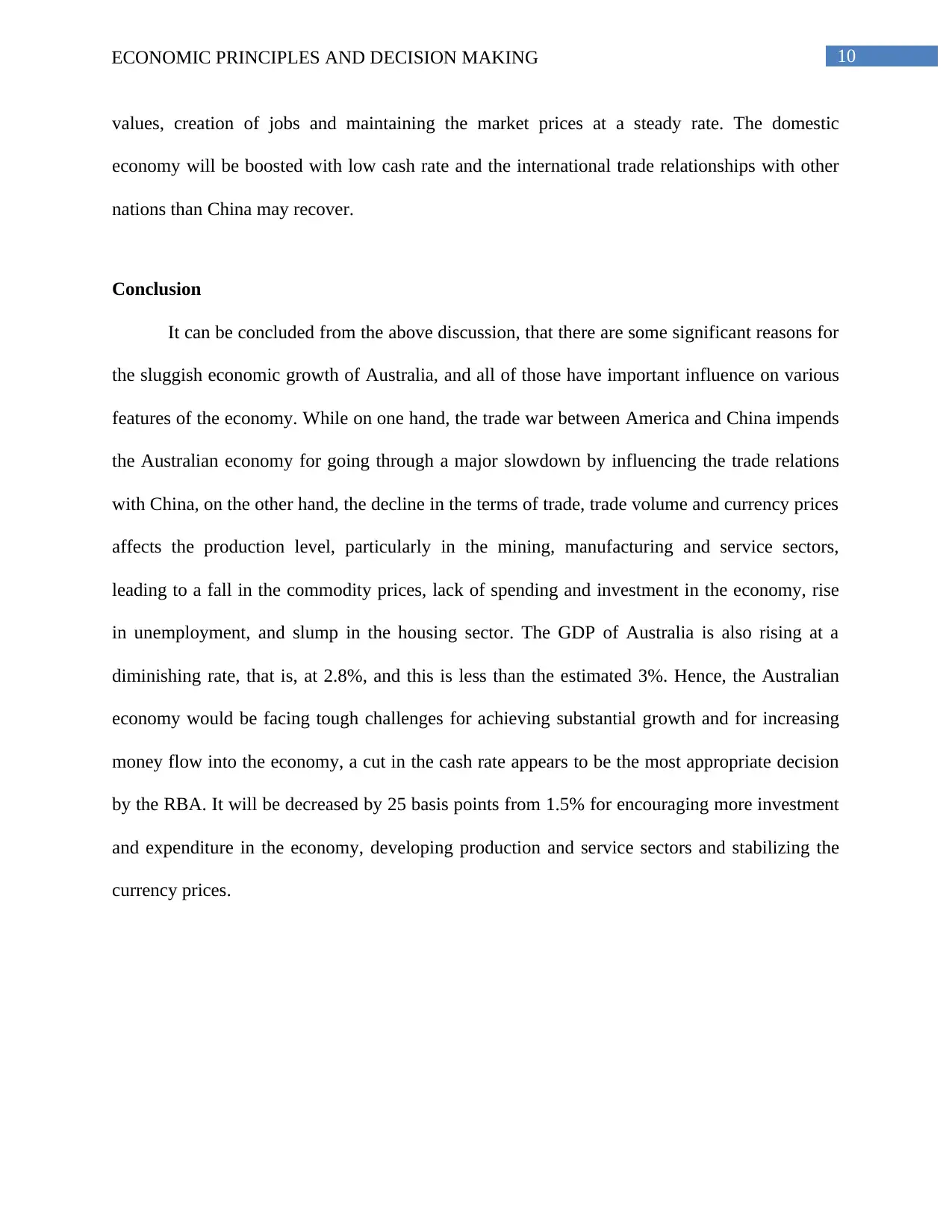
10ECONOMIC PRINCIPLES AND DECISION MAKING
values, creation of jobs and maintaining the market prices at a steady rate. The domestic
economy will be boosted with low cash rate and the international trade relationships with other
nations than China may recover.
Conclusion
It can be concluded from the above discussion, that there are some significant reasons for
the sluggish economic growth of Australia, and all of those have important influence on various
features of the economy. While on one hand, the trade war between America and China impends
the Australian economy for going through a major slowdown by influencing the trade relations
with China, on the other hand, the decline in the terms of trade, trade volume and currency prices
affects the production level, particularly in the mining, manufacturing and service sectors,
leading to a fall in the commodity prices, lack of spending and investment in the economy, rise
in unemployment, and slump in the housing sector. The GDP of Australia is also rising at a
diminishing rate, that is, at 2.8%, and this is less than the estimated 3%. Hence, the Australian
economy would be facing tough challenges for achieving substantial growth and for increasing
money flow into the economy, a cut in the cash rate appears to be the most appropriate decision
by the RBA. It will be decreased by 25 basis points from 1.5% for encouraging more investment
and expenditure in the economy, developing production and service sectors and stabilizing the
currency prices.
values, creation of jobs and maintaining the market prices at a steady rate. The domestic
economy will be boosted with low cash rate and the international trade relationships with other
nations than China may recover.
Conclusion
It can be concluded from the above discussion, that there are some significant reasons for
the sluggish economic growth of Australia, and all of those have important influence on various
features of the economy. While on one hand, the trade war between America and China impends
the Australian economy for going through a major slowdown by influencing the trade relations
with China, on the other hand, the decline in the terms of trade, trade volume and currency prices
affects the production level, particularly in the mining, manufacturing and service sectors,
leading to a fall in the commodity prices, lack of spending and investment in the economy, rise
in unemployment, and slump in the housing sector. The GDP of Australia is also rising at a
diminishing rate, that is, at 2.8%, and this is less than the estimated 3%. Hence, the Australian
economy would be facing tough challenges for achieving substantial growth and for increasing
money flow into the economy, a cut in the cash rate appears to be the most appropriate decision
by the RBA. It will be decreased by 25 basis points from 1.5% for encouraging more investment
and expenditure in the economy, developing production and service sectors and stabilizing the
currency prices.
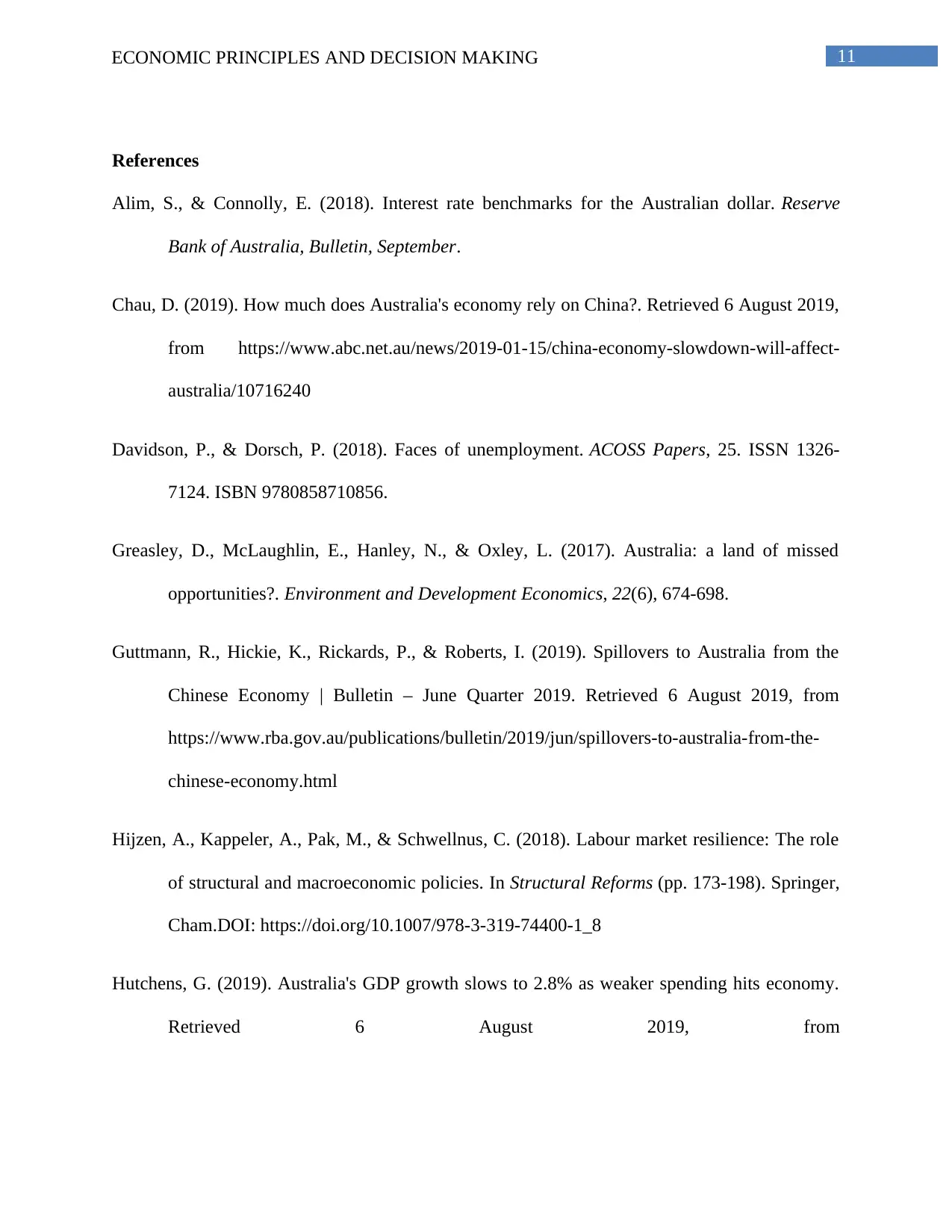
11ECONOMIC PRINCIPLES AND DECISION MAKING
References
Alim, S., & Connolly, E. (2018). Interest rate benchmarks for the Australian dollar. Reserve
Bank of Australia, Bulletin, September.
Chau, D. (2019). How much does Australia's economy rely on China?. Retrieved 6 August 2019,
from https://www.abc.net.au/news/2019-01-15/china-economy-slowdown-will-affect-
australia/10716240
Davidson, P., & Dorsch, P. (2018). Faces of unemployment. ACOSS Papers, 25. ISSN 1326-
7124. ISBN 9780858710856.
Greasley, D., McLaughlin, E., Hanley, N., & Oxley, L. (2017). Australia: a land of missed
opportunities?. Environment and Development Economics, 22(6), 674-698.
Guttmann, R., Hickie, K., Rickards, P., & Roberts, I. (2019). Spillovers to Australia from the
Chinese Economy | Bulletin – June Quarter 2019. Retrieved 6 August 2019, from
https://www.rba.gov.au/publications/bulletin/2019/jun/spillovers-to-australia-from-the-
chinese-economy.html
Hijzen, A., Kappeler, A., Pak, M., & Schwellnus, C. (2018). Labour market resilience: The role
of structural and macroeconomic policies. In Structural Reforms (pp. 173-198). Springer,
Cham.DOI: https://doi.org/10.1007/978-3-319-74400-1_8
Hutchens, G. (2019). Australia's GDP growth slows to 2.8% as weaker spending hits economy.
Retrieved 6 August 2019, from
References
Alim, S., & Connolly, E. (2018). Interest rate benchmarks for the Australian dollar. Reserve
Bank of Australia, Bulletin, September.
Chau, D. (2019). How much does Australia's economy rely on China?. Retrieved 6 August 2019,
from https://www.abc.net.au/news/2019-01-15/china-economy-slowdown-will-affect-
australia/10716240
Davidson, P., & Dorsch, P. (2018). Faces of unemployment. ACOSS Papers, 25. ISSN 1326-
7124. ISBN 9780858710856.
Greasley, D., McLaughlin, E., Hanley, N., & Oxley, L. (2017). Australia: a land of missed
opportunities?. Environment and Development Economics, 22(6), 674-698.
Guttmann, R., Hickie, K., Rickards, P., & Roberts, I. (2019). Spillovers to Australia from the
Chinese Economy | Bulletin – June Quarter 2019. Retrieved 6 August 2019, from
https://www.rba.gov.au/publications/bulletin/2019/jun/spillovers-to-australia-from-the-
chinese-economy.html
Hijzen, A., Kappeler, A., Pak, M., & Schwellnus, C. (2018). Labour market resilience: The role
of structural and macroeconomic policies. In Structural Reforms (pp. 173-198). Springer,
Cham.DOI: https://doi.org/10.1007/978-3-319-74400-1_8
Hutchens, G. (2019). Australia's GDP growth slows to 2.8% as weaker spending hits economy.
Retrieved 6 August 2019, from
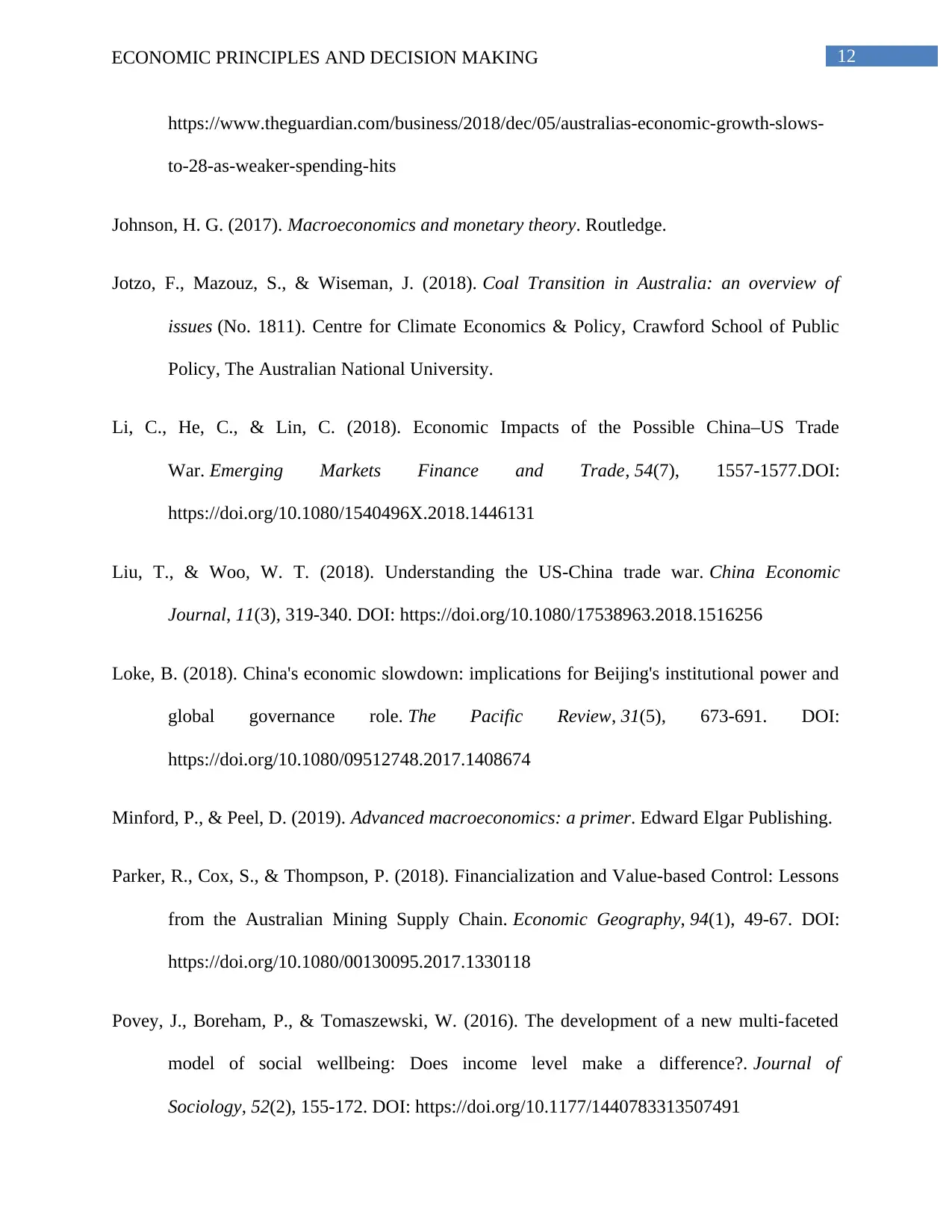
12ECONOMIC PRINCIPLES AND DECISION MAKING
https://www.theguardian.com/business/2018/dec/05/australias-economic-growth-slows-
to-28-as-weaker-spending-hits
Johnson, H. G. (2017). Macroeconomics and monetary theory. Routledge.
Jotzo, F., Mazouz, S., & Wiseman, J. (2018). Coal Transition in Australia: an overview of
issues (No. 1811). Centre for Climate Economics & Policy, Crawford School of Public
Policy, The Australian National University.
Li, C., He, C., & Lin, C. (2018). Economic Impacts of the Possible China–US Trade
War. Emerging Markets Finance and Trade, 54(7), 1557-1577.DOI:
https://doi.org/10.1080/1540496X.2018.1446131
Liu, T., & Woo, W. T. (2018). Understanding the US-China trade war. China Economic
Journal, 11(3), 319-340. DOI: https://doi.org/10.1080/17538963.2018.1516256
Loke, B. (2018). China's economic slowdown: implications for Beijing's institutional power and
global governance role. The Pacific Review, 31(5), 673-691. DOI:
https://doi.org/10.1080/09512748.2017.1408674
Minford, P., & Peel, D. (2019). Advanced macroeconomics: a primer. Edward Elgar Publishing.
Parker, R., Cox, S., & Thompson, P. (2018). Financialization and Value-based Control: Lessons
from the Australian Mining Supply Chain. Economic Geography, 94(1), 49-67. DOI:
https://doi.org/10.1080/00130095.2017.1330118
Povey, J., Boreham, P., & Tomaszewski, W. (2016). The development of a new multi-faceted
model of social wellbeing: Does income level make a difference?. Journal of
Sociology, 52(2), 155-172. DOI: https://doi.org/10.1177/1440783313507491
https://www.theguardian.com/business/2018/dec/05/australias-economic-growth-slows-
to-28-as-weaker-spending-hits
Johnson, H. G. (2017). Macroeconomics and monetary theory. Routledge.
Jotzo, F., Mazouz, S., & Wiseman, J. (2018). Coal Transition in Australia: an overview of
issues (No. 1811). Centre for Climate Economics & Policy, Crawford School of Public
Policy, The Australian National University.
Li, C., He, C., & Lin, C. (2018). Economic Impacts of the Possible China–US Trade
War. Emerging Markets Finance and Trade, 54(7), 1557-1577.DOI:
https://doi.org/10.1080/1540496X.2018.1446131
Liu, T., & Woo, W. T. (2018). Understanding the US-China trade war. China Economic
Journal, 11(3), 319-340. DOI: https://doi.org/10.1080/17538963.2018.1516256
Loke, B. (2018). China's economic slowdown: implications for Beijing's institutional power and
global governance role. The Pacific Review, 31(5), 673-691. DOI:
https://doi.org/10.1080/09512748.2017.1408674
Minford, P., & Peel, D. (2019). Advanced macroeconomics: a primer. Edward Elgar Publishing.
Parker, R., Cox, S., & Thompson, P. (2018). Financialization and Value-based Control: Lessons
from the Australian Mining Supply Chain. Economic Geography, 94(1), 49-67. DOI:
https://doi.org/10.1080/00130095.2017.1330118
Povey, J., Boreham, P., & Tomaszewski, W. (2016). The development of a new multi-faceted
model of social wellbeing: Does income level make a difference?. Journal of
Sociology, 52(2), 155-172. DOI: https://doi.org/10.1177/1440783313507491
Paraphrase This Document
Need a fresh take? Get an instant paraphrase of this document with our AI Paraphraser
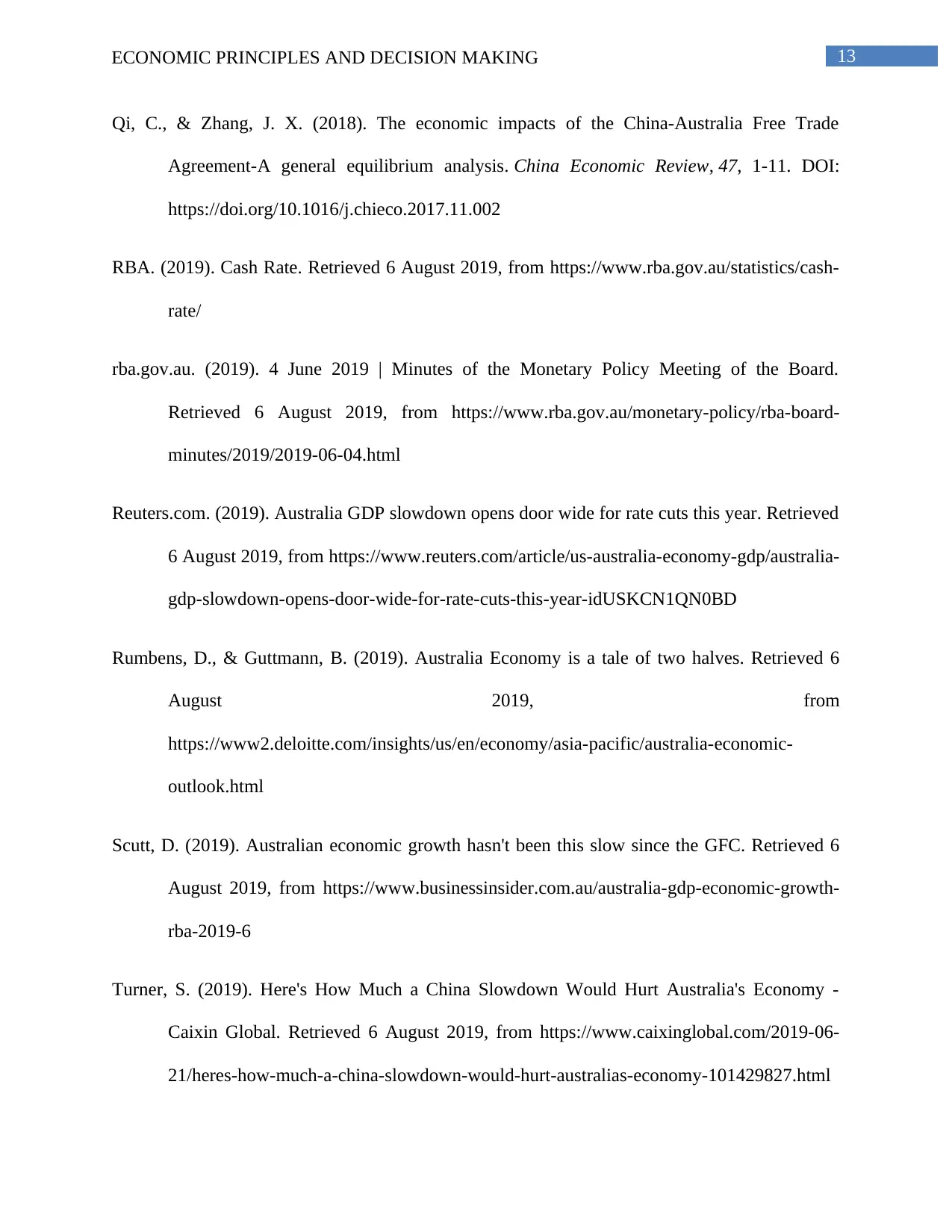
13ECONOMIC PRINCIPLES AND DECISION MAKING
Qi, C., & Zhang, J. X. (2018). The economic impacts of the China-Australia Free Trade
Agreement-A general equilibrium analysis. China Economic Review, 47, 1-11. DOI:
https://doi.org/10.1016/j.chieco.2017.11.002
RBA. (2019). Cash Rate. Retrieved 6 August 2019, from https://www.rba.gov.au/statistics/cash-
rate/
rba.gov.au. (2019). 4 June 2019 | Minutes of the Monetary Policy Meeting of the Board.
Retrieved 6 August 2019, from https://www.rba.gov.au/monetary-policy/rba-board-
minutes/2019/2019-06-04.html
Reuters.com. (2019). Australia GDP slowdown opens door wide for rate cuts this year. Retrieved
6 August 2019, from https://www.reuters.com/article/us-australia-economy-gdp/australia-
gdp-slowdown-opens-door-wide-for-rate-cuts-this-year-idUSKCN1QN0BD
Rumbens, D., & Guttmann, B. (2019). Australia Economy is a tale of two halves. Retrieved 6
August 2019, from
https://www2.deloitte.com/insights/us/en/economy/asia-pacific/australia-economic-
outlook.html
Scutt, D. (2019). Australian economic growth hasn't been this slow since the GFC. Retrieved 6
August 2019, from https://www.businessinsider.com.au/australia-gdp-economic-growth-
rba-2019-6
Turner, S. (2019). Here's How Much a China Slowdown Would Hurt Australia's Economy -
Caixin Global. Retrieved 6 August 2019, from https://www.caixinglobal.com/2019-06-
21/heres-how-much-a-china-slowdown-would-hurt-australias-economy-101429827.html
Qi, C., & Zhang, J. X. (2018). The economic impacts of the China-Australia Free Trade
Agreement-A general equilibrium analysis. China Economic Review, 47, 1-11. DOI:
https://doi.org/10.1016/j.chieco.2017.11.002
RBA. (2019). Cash Rate. Retrieved 6 August 2019, from https://www.rba.gov.au/statistics/cash-
rate/
rba.gov.au. (2019). 4 June 2019 | Minutes of the Monetary Policy Meeting of the Board.
Retrieved 6 August 2019, from https://www.rba.gov.au/monetary-policy/rba-board-
minutes/2019/2019-06-04.html
Reuters.com. (2019). Australia GDP slowdown opens door wide for rate cuts this year. Retrieved
6 August 2019, from https://www.reuters.com/article/us-australia-economy-gdp/australia-
gdp-slowdown-opens-door-wide-for-rate-cuts-this-year-idUSKCN1QN0BD
Rumbens, D., & Guttmann, B. (2019). Australia Economy is a tale of two halves. Retrieved 6
August 2019, from
https://www2.deloitte.com/insights/us/en/economy/asia-pacific/australia-economic-
outlook.html
Scutt, D. (2019). Australian economic growth hasn't been this slow since the GFC. Retrieved 6
August 2019, from https://www.businessinsider.com.au/australia-gdp-economic-growth-
rba-2019-6
Turner, S. (2019). Here's How Much a China Slowdown Would Hurt Australia's Economy -
Caixin Global. Retrieved 6 August 2019, from https://www.caixinglobal.com/2019-06-
21/heres-how-much-a-china-slowdown-would-hurt-australias-economy-101429827.html
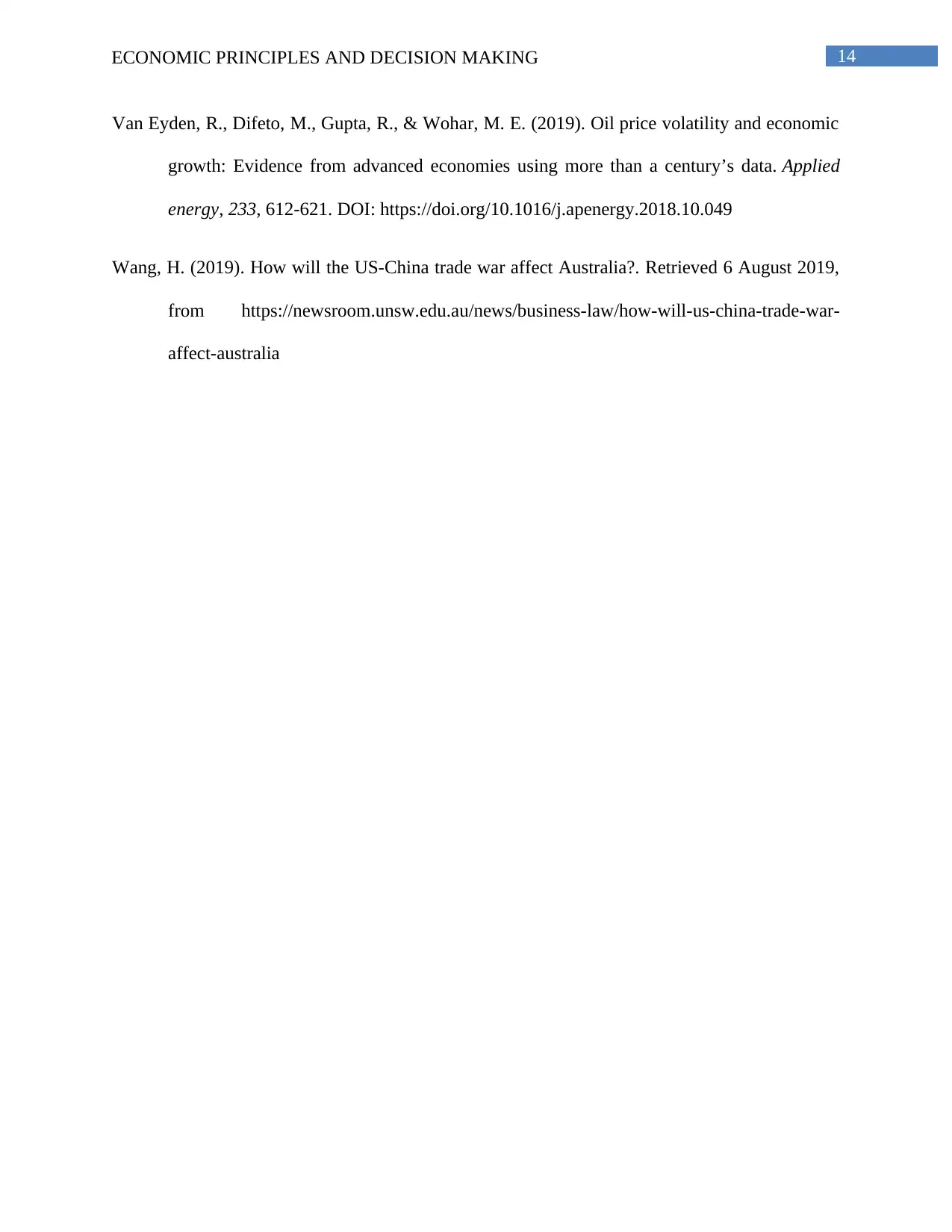
14ECONOMIC PRINCIPLES AND DECISION MAKING
Van Eyden, R., Difeto, M., Gupta, R., & Wohar, M. E. (2019). Oil price volatility and economic
growth: Evidence from advanced economies using more than a century’s data. Applied
energy, 233, 612-621. DOI: https://doi.org/10.1016/j.apenergy.2018.10.049
Wang, H. (2019). How will the US-China trade war affect Australia?. Retrieved 6 August 2019,
from https://newsroom.unsw.edu.au/news/business-law/how-will-us-china-trade-war-
affect-australia
Van Eyden, R., Difeto, M., Gupta, R., & Wohar, M. E. (2019). Oil price volatility and economic
growth: Evidence from advanced economies using more than a century’s data. Applied
energy, 233, 612-621. DOI: https://doi.org/10.1016/j.apenergy.2018.10.049
Wang, H. (2019). How will the US-China trade war affect Australia?. Retrieved 6 August 2019,
from https://newsroom.unsw.edu.au/news/business-law/how-will-us-china-trade-war-
affect-australia
1 out of 15
Related Documents
Your All-in-One AI-Powered Toolkit for Academic Success.
+13062052269
info@desklib.com
Available 24*7 on WhatsApp / Email
![[object Object]](/_next/static/media/star-bottom.7253800d.svg)
Unlock your academic potential
© 2024 | Zucol Services PVT LTD | All rights reserved.





